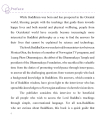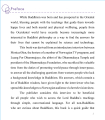non-returner : ค้นหาหนังสือธรรมะ หน้า 2 / 9
หน้าหนังสือทั้งหมด

130
Systematic Training Programme for Spreading Buddhism
The Systematic Training Programme for Spreading Buddhism began in 1999-2007, with a total of 71 classes completing the Programme. There have been 8.090 monks from 5.833 temples, from across the countr
The Systematic Training Programme for Spreading Buddhism, initiated from 1999 to 2007, has successfully trained 8,090 monks from 5,833 temples across Thailand, promoting the teachings of the Buddha. T

6
The Teachings of Luang Phaw Dhammajayo
immersing himself in the study and practice of the
Buddha's pure teachings. For almost 40 years, he
has always emphasized to the thousands of those
who follow his teachings at the Dhammakaya
Temple, b
Luang Phaw Dhammajayo has dedicated nearly 40 years to promoting the Buddha's teachings, asserting that true world peace originates from inner peace. He emphasizes everyone's role in enhancing humanit

34
Understanding the Three Characteristics of Existence
When we receive fortune, prestige, recognition or happiness,
our minds will remain calm, not overwhelmed or attached.
A person who is aware of suffering and happiness has
trained the mind to be as s
This text discusses the importance of understanding the Three Characteristics of existence: Impermanence, Suffering, and Non-self. It emphasizes that fortune, prestige, and happiness are temporary and

73
Supramundane Paths and Fruits in Dhammakāya
supramundane paths and fruits. 113 The ‘four pairs’ are mentioned instead when particular paths and their corresponding fruits are collectively called under the same titles. Of the eight transcendenta
The text discusses the different transcendental levels of dhammakāya, highlighting the distinction between trainees and non-trainees. The first seven levels correspond to qualities of trainees, wherea

63
Concepts of Enlightenment in Buddhism
อายามูชุ cause of ruin; roads to ruin; gateway to destruction
อัย Tant giving of forgiveness
อั ญ ญา super-knowledge; ultra-conscious insight; divine
อิ ธรรม power; spiritual power; supranatural
บทเรียนสำคัญเกี่ยวกับแนวคิดในพระพุทธศาสนา ได้แก่ อายามูชุ (ภาวะสูญเสีย), อรหันต์ (บุคคลผู้มีคุณธรรม), อริยสัจ ๔ (ความจริงอันสูงสุด ๔ ประการ) ซึ่งเป็นรากฐานในการตีความศาสนา พระพุทธเจ้าทรงค้นพบความจริงเ

56
The Story of the Disciples of Non-Buddhist Teachers
6 The Story of the Disciples of Non-Buddhist Teachers
While residing at the Jetavana Monastery, the Buddha spoke these verses, with reference to some disciples of the Titthis (non-Buddhist ascetics).
In the context of the Jetavana Monastery, the Buddha narrates a tale involving disciples of non-Buddhist ascetics known as Titthis. These disciples prohibited their children from mingling with those o

58
The Story of the Disciples of Non-Buddhist Teachers
56
Clear-minded Youths - 6 The Story of the Disciples of Non-Buddhist Teachers
The Buddha then told the boy to tell the non-Buddhist boys to come and have water at the monastery.
The parents of th
This passage discusses an encounter where the Buddha encourages non-Buddhist youths to embrace his teachings. Their parents, initially distressed by their disloyalty, are persuaded to send the boys to

12
การศึกษาวิเคราะห์เชิงทฤษฎีประเภทนิยมของพระนารถในคัมภีร์มัลมะยะมะกะรัง
การศึกษาวิเคราะห์เชิงทฤษฎีประเภทนิยมของพระนารถในถ้อยคำในคัมภีร์มัลมะยะมะกะรัง (The Analytical Study of the Affirmative Catuskoti by Nâgarjuna in Mūlamadhyamakakārikā Scripture
143
ต่อไปนี้จะเป็นรายละเ
บทความนี้นำเสนอการศึกษาเชิงวิเคราะห์ของประเภทนิยมของพระนารถในคัมภีร์มัลมะยะมะกะรัง โดยเฉพาะในการสร้างประโยคคาถุตามลักษณะของประจน์ทางตรรกศาสตร์ ผ่านการพิจารณาโครงสร้างของประโยคในรูปแบบแสดงทัศนะต่าง ๆ อ

66
The Virtue of Approving in Velāma Sutta
66
The Virtue of Approving
7. Velāma Sutta
"Now, householder, if the thought should occur to you,
'Perhaps it was someone else who at that time was
Velāma the brahman, who gave that gift, t
In the Velāma Sutta, the householder is reminded that true merit comes not from the quantity or grandeur of gifts, but from the character and realization of those who receive them. The teaching emphas

53
ศีลพรตและศีลธรรม
ศีลพรต
ศีลธรรม morality; morals; ethics
ศีล ๕ Five Precepts, consisting of:
1. not to kill
2. not to steal
3. not to commit sexual misco
ศีลพรตเป็นแนวทางปฏิบัติทางศีลธรรมที่สำคัญในศาสนา โดยมีศีล ๕ ซึ่งยกตัวอย่างเช่น ไม่ฆ่าสัตว์ ไม่ขโมย ไม่ประพฤติผิดทางเพศ ไม่โกหก และไม่ดื่มสุรา ศีลธรรมช่วยให้เกิดความสงบสุขในชีวิตและมีแนวทางการปฏิบัติที

43
การตักบาตรและคำศัพท์ภาษาอังกฤษ
และในเดือนมีนาคมที่ผ่านมา เราก็มีงานตักบาตรกันอย่างตลอดต่อเนื่อง ทราบว่าน้องๆ
อาสาสมัครหลายๆ ท่านก็อยากฝึกคำศัพท์ภาษาอังกฤษเกี่ยวกับการตักบาตร เรามาดูกันต่ออีก
หน่อยเลยนะคะ
ตักบาตร = offer alms (ออฟเฟ
ในบทความนี้เราจะมาพูดถึงกระบวนการตักบาตรและคำศัพท์ภาษาอังกฤษที่เกี่ยวข้องกับการทำบุญ เช่น 'offer alms', 'layman', และ 'non-perishable food'. นอกจากนี้ยังมีการอธิบายเสียงออกเสียงของคำที่อาจจะยากเพื่อให

52
Glossary of Key Buddhist Terms
1. Arahant
Glossary
An enlightened being who is free from defilements
and no longer subjected to rebirths or has attained
Nibbana.
2. Bodhisatta
One who determines to be a Buddha in the future.
3. Dha
This glossary provides definitions of key terms in Buddhism, including Arahant, an enlightened being who has attained Nibbana, Bodhisatta, a future Buddha, and Dhamma, referring both to ultimate truth

4
Buddha Knows: A Journey into Buddhist Philosophy
Preface
While Buddhism was born and has prospered in the Oriental
world, blessing people with the teachings that guide them towards
happy lives and both mental and physical wellbeing, people from
the
In 'Buddha Knows', Monica Øien interviews Luang Phaw Dhammajayo, the abbot of the Dhammakaya Temple, as he addresses questions from the Western world about Buddhist philosophy. This book serves as a b

177
Understanding Austerity and Mindfulness in Buddhist Practice
observing the eight precepts, and meditating. Those who wish
to practice must stay at a temple. Accommodations can depend
on the geographical conditions where the temples are located
and their ability
บทเรียนเรื่องการอุทิศตนให้อื่นได้รับการอธิบายโดยพระอาจารย์ซึ่งชี้ให้เห็นว่าวิธีการปฏิบัติอาจช่วยให้เราเข้าใจความต้องการและความปรารถนา ตัวอย่างเช่น ผู้คนมักแยกแยะความต้องการและความปรารถนาออกจากกันไม่ถู

181
Understanding Internal and External Fools in Buddhism
1) External Fools include non-Buddhists. They are
determined to demolish Buddhism, whether they are of other
religious affiliations or not. They typically try to cast aspersions
upon Buddhist monks. W
The text discusses two types of fools in Buddhism: External Fools, who are non-Buddhists aiming to undermine the faith by misrepresenting its teachings, and Internal Fools, who are Buddhists lacking r

195
Understanding the Three Characteristics of Buddhism
Characteristics (tilakkhana), consisting of impermanence
(aniccata), suffering (dukkhata), and non-self (anattata). This
truth stands behind all living beings in this world.
The truths of the Law of K
This text explores the Three Characteristics of Buddhism—impermanence, suffering, and non-self. It discusses how misconceptions among children regarding Buddhist teachings and monks can hinder their u

5
Exploring Buddhism: A Guide for the Curious
Preface
While Buddhism was born and has prospered in the Oriental
world, blessing people with the teachings that guide them towards
happy lives and both mental and physical wellbeing, people from
the
This book presents a valuable interview between Norwegian TV host Monica Øien and Luang Por Dhammajayo, the abbot of the Dhammakaya Temple. It addresses challenging questions about Buddhism from a Wes

6
Introducing Thai Theravada Wisdom for All Cultures
Forward
When we want to introduce a new food item to the
population of a country, we have to adjust the seasoning
to fit the general tastes and flavor of the country that the
new food is for. It is no
This text discusses the adaptation of the original Thai Theravada Buddhist book, 'The Warm Hearted Family,' for a broader audience. It emphasizes that, similar to how pizza can be enjoyed by anyone, t

7
Understanding the Mind in Thai Culture
"this or that", "black or white", with no gray area, as the
locals find this logic easy to grasp and put into practice. In
addition, Thai culture and language has a relatively large
amount of words an
This text discusses the simplicity of dualistic thinking in Thai culture and the rich linguistic resources that explain human cognition. It emphasizes that terms often linked to Buddhism should be tre

184
Glossary of Key Concepts in Buddhist Philosophy
Part Seven: Appendixes
Glossary
Anattata: Non-self; nothing in the world has implicit
identity
"There is nothing out there, not even our bodies, which
we can control. Thus, it is not distinctly ours.
This glossary provides definitions for key Buddhist concepts such as Anattata (non-self), Aniccata (impermanence), and Bhavana (meditation). It emphasizes the understanding that nothing possesses a pe
